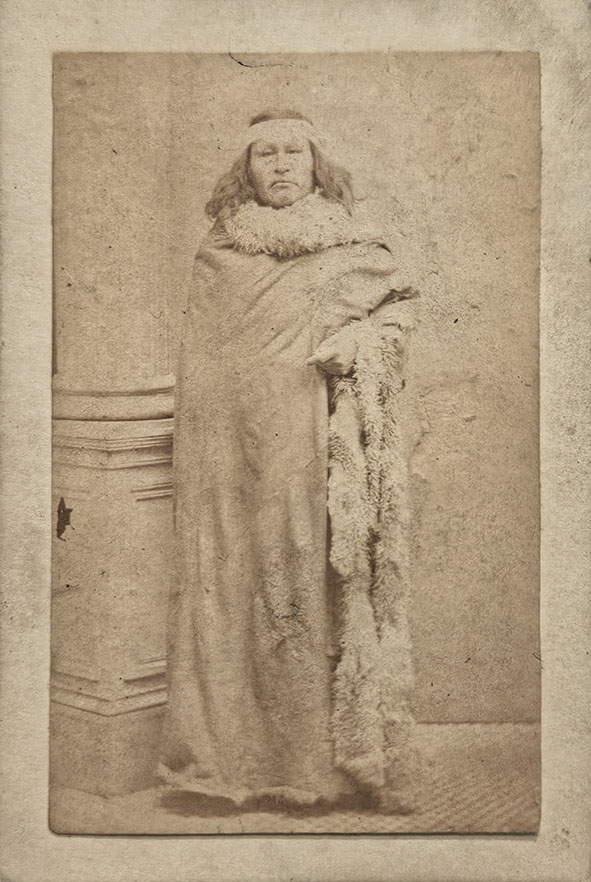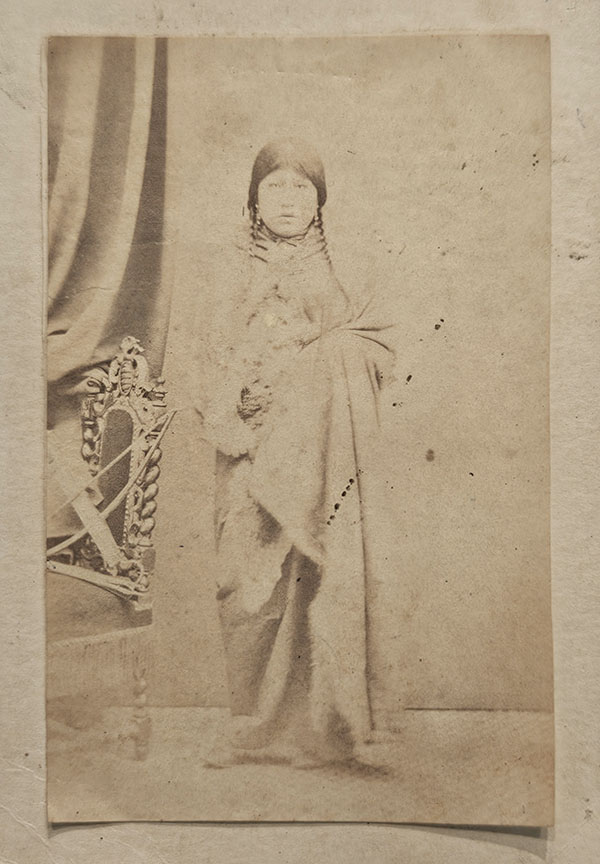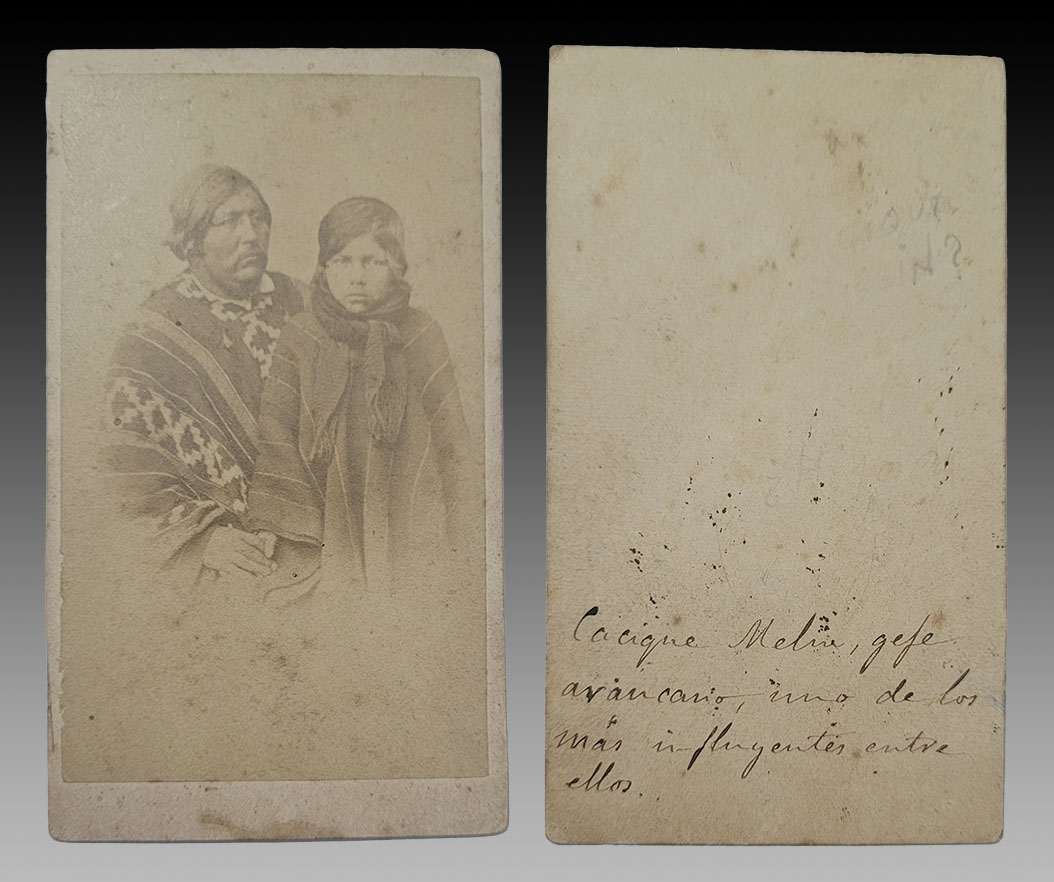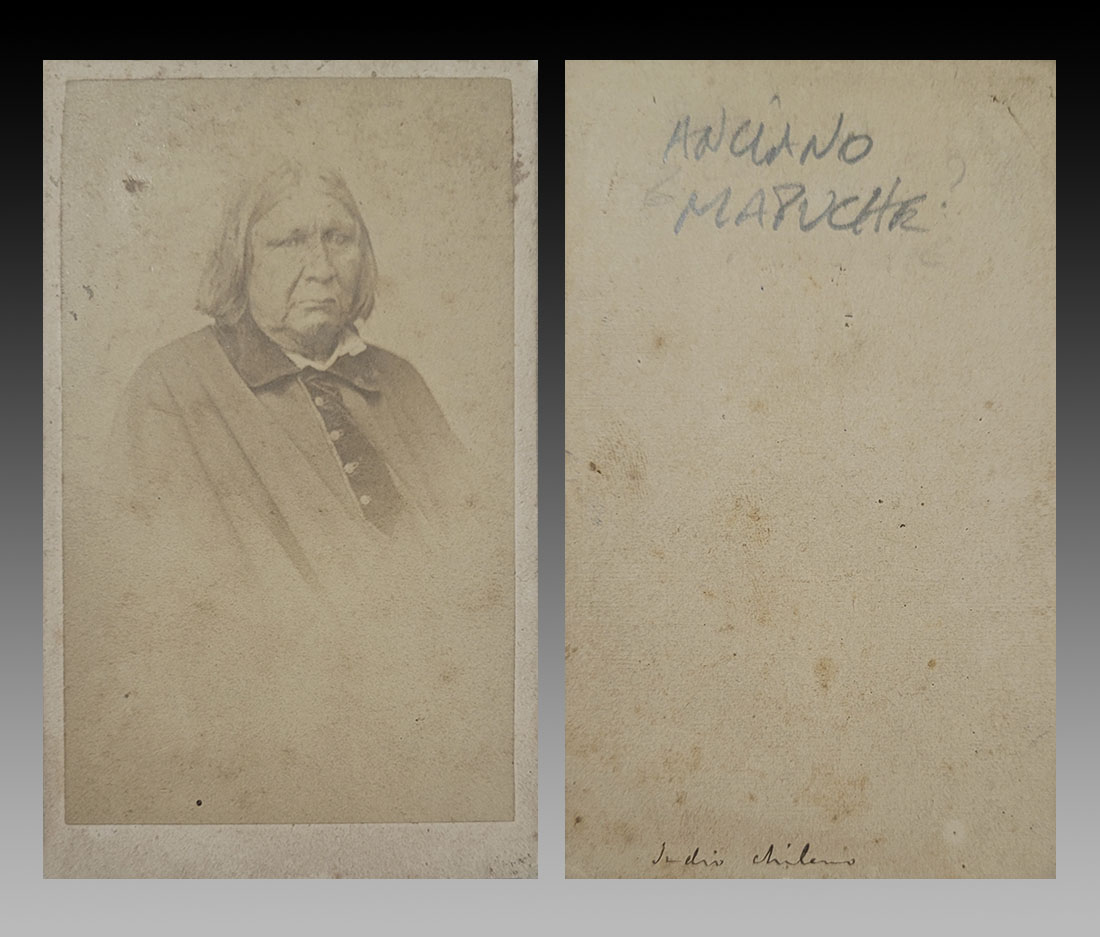The recent discovery in Montevideo -Uruguay- of four early portraits expands the scarce Tehuelche and Mapuche iconography of the founding period of photography and opens new perspectives in the field of historical and anthropological research.
Furthermore, it allows us to have the hope of future surprises to the extent that this research is disseminated not only in academic spaces, but also among our population, since it is home to the largest and richest heritage formed with photographic memory.
Regarding this special iconography, we must point out that, in a first stage, these native peoples were documented in drawings and paintings made by European explorers and itinerant artists, many of them transferred to woodcut and steel engravings, and to innovative lithographs. The publishing industry promoted the development of these illustrations intended to enrich travelers' chronicles or to compose authentic albums that, due to their visual charm, captivated an audience eager to discover the most remote places on the planet.
In the midst of the development of this European fashion that was advancing throughout the world, the invention of photography arrived in these countries in southern America and it was then that the documentary panorama changed completely under the shelter of this new mechanical technology whose basis was converted cameras. obscure and complicated chemical formulas.
However, we must highlight that, to date, no record has been located about Tehuelches - or other indigenous ethnic groups of our nations - taken with the pioneering processes of the daguerreotype or ambrotype, an understandable reality since those processes consisting of unique positive works had to be executed. on the spot with their shooting and developing equipment, and the work had to accompany its author with the risks that those trips implied. However, this absence is surprising since by populating the lands close to the only circumnavigation route -Atlantic/Pacific- of the time, one would think that some pioneer had made such a record of natives in their habitat. This hypothesis allows us to harbor a remote hope of locating in some European or North American museum or archive, that record of Patagonian and Fuegian indigenous people hitherto unknown.
Photographic documentation on indigenous groups in our country then began in the 1860s; It was when the negative-positive process landed with its wet collodion glass negatives and contact copies on albumen or albuminated paper. This new technique had its most popular expression in the small business cards – 6 x 9 cm – of French origin, the so-called "carte-de-visite".
With them, the fever of "cartomania" broke out in almost all social classes - the lowering of its costs allowed the photographic portrait to be democratized, making it available to a large part of society. This avid public drove demand to the point of allowing us today to explain the multiplication of brand-new photographic studios. At that time in Buenos Aires, the German Adolfo Alexander ran three stores simultaneously, as did the Brazilian Christiano Junior, and this abundance of family portraits resulted in the invention of the photographic album.
In their desire to expand their commercial horizon, photographic studios offered for sale portraits in "carte-de-visite" of great national and international figures - generals, bishops, heroes of Independence, queens, emperors, famous artists, etc. - which They used to lead the family saga in the aforementioned albums. It is now understood that these "exotic" images about the indigenous world were part of this group, in addition to being highly sought after by international travelers, museums and study centers in Europe and the United States.
The production of this special iconography can be divided into two large groups; the one carried out in the same territory with travel cameras and in a "plein air" mode on groups and even reflecting their tolderías and rucas [homes of the Mapuche people], and the careful records obtained in photographic studios, the vast majority established in the cities. most important, such as Buenos Aires, Valdivia and Santiago de Chile. Among those precursors we can mention Esteban Gonnet, Benito Panunzi, Peter Adams, Rafael Castro y Ordoñez, John Bell Hatcher, Federico Kohlmann and Alberto de Agostini, extending to the beginning of the 20th century. The researcher Osvaldo Mondelo in his book dedicated to the photography of Tehuelches, records a total of 45 photographers identified with images captured of this ancient town.
A small and large portrait gallery
The four photographic works that feature in this article were taken in two professional studios; the two that we will address first, on Argentine soil, and the rest in Chile. The first with portraits of Tehuelches, and the other two, with Mapuches. Both pairs were reunited over the years in the hands of a Uruguayan collector and will be part of an upcoming auction organized by Hilario. Arts Letters Trades and Zorrilla Auctions, a fruitful alliance of two prestigious houses installed on both banks of the Río de la Plata.
When the business cards were selected to participate in the sale scheduled for the month of August, I was notified about the find and happy, I shared the good news with my colleague Osvaldo Mondelo, specialized in photography about the Tehuelche people, who promptly requested permission for its inclusion in an upcoming book, Mulato (Chümjaluwun) When the sheep ran to the Tehuelches of Patagonia, which was already going to press in Santiago, Chile. But, without sufficient time, that attempt could not be realized, much to the regret of the author, who after decades of searching and studying, was surprised by the discovery of these portraits.
The story of Casimiro Biguá or Bivois, the documented indigenous authority that we could address as the first take, has special characteristics. He was a "tonguaraz" of the chief Centurión, companion of the English explorer George Musters, friend of Commander Luis Piedrabuena and confidential informant of the chief Sayhueque, head of the heterogeneous confederation of Tehuelche and Mapuche indigenous people. Biguá held high military positions - captain and lieutenant colonel - in the Chilean and Argentine armies, and was an actor in the territorial disputes between both countries.
In the early years of the 1860s Biguá accompanied the sailor Luis Piedrabuena on his trip to Buenos Aires for an interview with President Bartolomé Miter himself and, on that occasion, he was photographed, among other photographers, by the German Adolfo Alexander along with his daughter Juana in other images. We must point out that Alexander introduced Piedrabuena to Argentine Freemasonry as Alcibiades Lappas informs us.
Annotations added to the back of each portrait, undoubtedly the work of the same informant.
The information contained on the back of the card about his move to Uruguay is completely new and undoubtedly opens a new door in the study of the life of Casimiro Biguá. The fact is that on the free side of the secondary support, in a modern handwritten text made with different inks and even with pencil, it reads: "Cacique Casimiro Biguá [Tehuelche]. Indian who lived in the ranch of John Mac Coll [1] in the 9th judicial section of the Department of San José [current Paraje Chamangá Flores]. Photograph Jouant Hnos. Montevideo. The author of these annotations did the same in the following portrait of Juana Biguá, although in this he placed a question mark preceding the information about his time in the stay of that Scot living in Uruguay, and as a final piece of information, he added that, “according to Florita Mac Coll [John's daughter] was Biguá's wife", responding to another question placed right there: "India Tehuelche / Wife or daughter Juana? of Cacique Casimiro “Biguá” [Tehuelche]». For the unknown author of these annotations, both photographs were taken in the studio of Jouant Hnos, in Montevideo, or at least there these copies were made - without indications of authorship, we clarify - by them and marketed.
It was common in those years for images to be reproduced by other professional photographers; some offered them on their cardboard printed with the studios' advertisements and others, mounted on simple white and anonymous cardboard; in both versions without respecting copyright.
On the left, the portrait that Adolfo Alexander took of them in his studio on 37 Artes Street, in Buenos Aires. On the right, an engraving that reproduces that photograph. In Tehuelches. Dance with photos, by Osvaldo Mondelo.
Already announced, we will now deal with the next portrait, with the full-length figure of Juana, wife or daughter of Biguá? To clear up all doubt about her identity, we will say that the Patagonian historian Osvaldo Mondelo in his masterpiece Tehuelches. Dance with Photos (2012) indicates in this regard: "Juana was the eldest of Casimiro's four children and had a Christian name. Her brothers were Sam Slick, Gabriel and Chingook. She was the wife of Cuastro, a tragic character about whom George Musters speaks in his chronicle entitled Journey among the Patagonians".
Juana's clothing consists of a long cover made of guanaco skin - quillango - that reaches to her feet attached to the height of the neck, a formidable coat to face the rigor of the Patagonian climate. She poses standing in the studio, looking towards the camera and, next to her on the chair with a backrest of Solomonic columns, a bow and arrows are shown, surely her father's. The decoration of the room consists of a smooth, light curtain complemented by a heavy pleated curtain. The lighting used in this aerial box is natural.
On the western side of the mountain range, Mapuches or Araucanians
Located at the same time, and in the two images that now concern us in the Chilean portion of Patagonia, the Mapuches were a subject of interest for numerous traveling photographers and also for those installed in the urban centers of that country. We expressed it previously, the representations of these indigenous settlers reached a high demand in the Northern hemisphere and even, among those who made their photographic albums at the local level, bringing together, along with images of family and friends, the striking portraits of national personalities and foreigners, and exotic figures that enriched the originality of the set, at first, always in the small format of carte-de-visite.
In a record not located among the books we consulted, we are moved by the family scene of an Araucanian chief - in this case, the chief Meliá - posing next to his son and one can imagine, both for the first time in their lives faced with a camera; The scene is very emotional and his hands say it all. The little boy looks very intently at that mysterious machine that points its four golden "cannons" at him. To highlight his figures, the Huinca portraitist has created a fading effect.
Both wear striking ponchos; that of the chief, with three streets of work that show staggered geometric figures, the garments speak very loudly about the skill of the Mapuche weavers. In ancestral looms, spindle-spun sheep's wool became a garment that, in addition to being useful and beautiful, transmitted messages in its decoration, and dignified the community power of the wearer.
In the fourth and last portrait of this unique Montevideo discovery, we find the figure of an elderly Mapuche, perhaps born at the end of the 18th century or just beginning the next. His penetrating gaze, directed at the horizon, transports us to a life full of adventures and emotions.
During the second half of the 19th century, portraits of indigenous people posing in photographic studios have been very rare and, for this reason, these images achieve a high iconographic value due to the singular precision of those gallery cameras and the added value of a correct lighting on the subject.
From a distance in time, it is understood that the four portraits circulated through different geographies driven by the popular fashion of the so-called "Carte-de-visite". This leap in the consumption of images dominated the brand new photographic market since the 1860s. Locating them today is of vital importance for the study of those who posed in front of the cameras. And when the discovery places us in front of unknown images, its testimonial value increases. !! Congratulations!!
Note:
1. Scottish by origin, John Mac Coll settled in Uruguay where he died in 1886. He was a member of the Board of Founders of the Central Railway of Uruguay [1866] and owner of ranches. It is stated that he was the author of a Guide for emigrants to Uruguay published in London in 1862. In Feeling the place. Uruguay - Scotland Dialogue, Montevideo, Linardi and Risso, 2011.
We appreciate the information provided by Andrés Linardi.
* Special for Hilario. Arts Letters Trades
In the footsteps of a photograph of Cacique Casimiro Biguá or Bibois
By Osvaldo Mondelo *
The notes or references written on the back of old photographs usually raise more questions than certainties. Most of these annotations have been written after the author's photographic time and become ambiguous, imprecise and vague sources. Some work.
The manuscript added to the back of the unpublished photographs of Casimiro and his daughter Juana is a sign that calls us to continue investigating the multifaceted life of this Tehuelche chief. Key in the territorial dispute of Patagonia due to the diplomacy of Argentina and Chile.
There is documentation from 1845 about his trip to Santiago de Chile, during the government of President Manuel Bulnes (1841-1846) and also about his visits, between the years 1864-66, to the city of Buenos Aires where he was photographed by prestigious photographers, among them Esteban Gonnet, Benito Panunzi, Adolfo Alexander and the Photographic Art Gallery of Francis Meek and Guillermo Kelsey, but we have no data of their presence in a stay in Uruguay. However, we must remember that throughout the second half of the 19th century, maritime transit between the Malvinas Islands and the port of Montevideo was a frequent route for the few vessels that traveled along the Patagonian coasts. Among them, that of his friend, collector and business partner of leather and ostrich feathers, Captain Luis Piedrabuena, who took him in his packet on one or two occasions to meet with the Argentine authorities. His eldest son, whose original name we do not know, received, according to George Muster, in his book Life among Patagonians, the nickname Sam Slick in the southern archipelago from the Falkland Islands sailors.
Was Casimiro also in Port Stanley? Will he have landed in Montevideo and from there, a brief residence in the ranch of the Scottish rancher John Mac Coll? Was he portrayed in the famous Montevideo studio of Jovant brothers? These are mysteries to be answered. The truth is that behind every old photograph (front and back) there is a fantastic story to discover and tell.
* Special for Hilario. Arts Letters Trades
Osvaldo Mondelo
Historical-photographic researcher. He is the author of Tehuelches, Dance with Photos and Mulato (Chünjalawum). When the sheep ran to the Tehuelches in Patagonia next edition.



